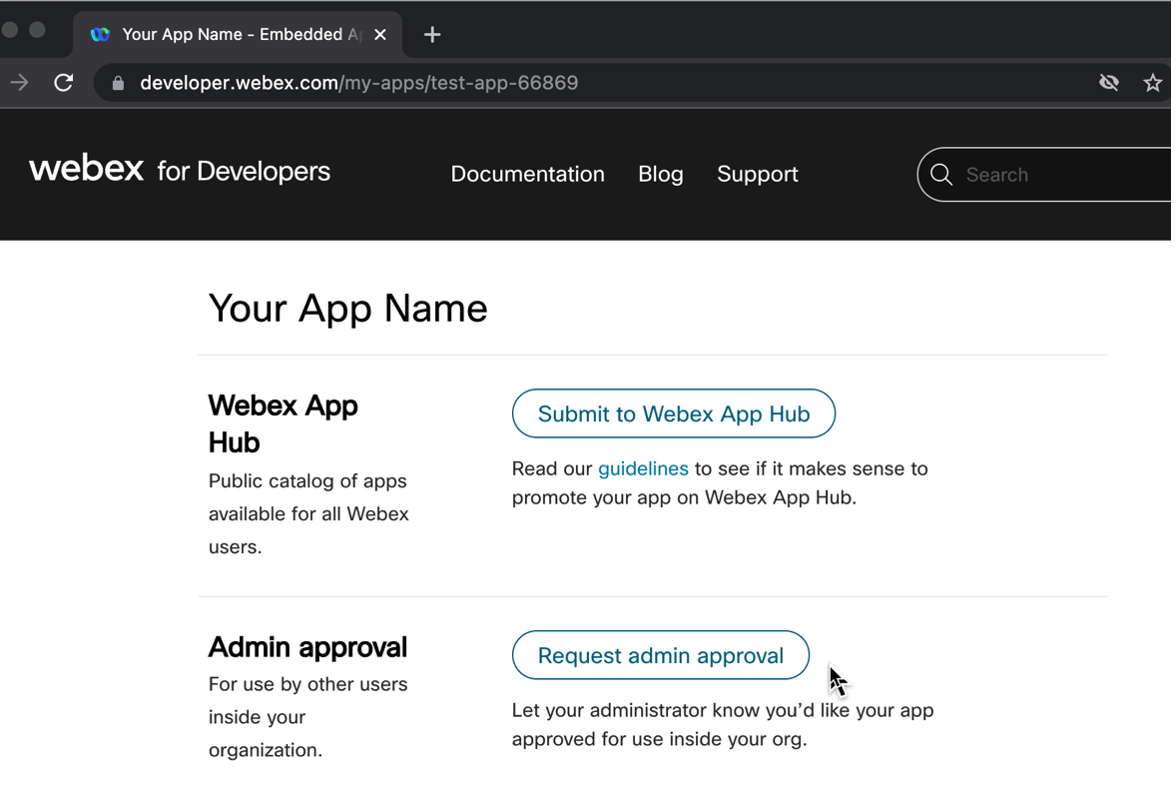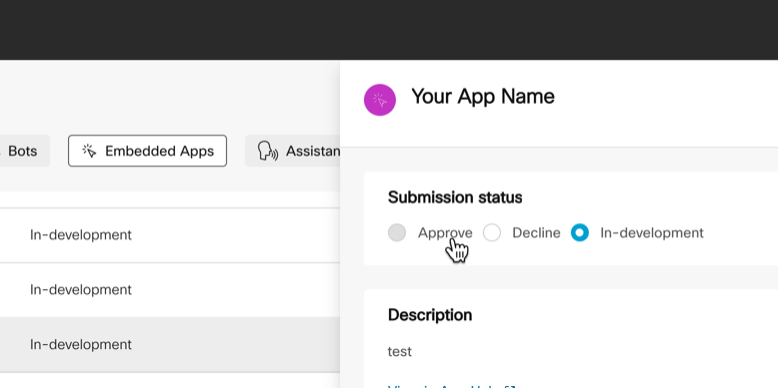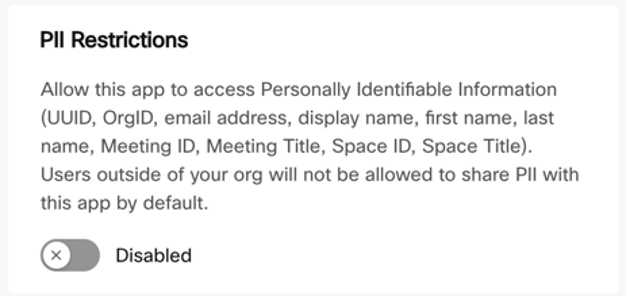Build
Frequently Asked Questions
If you don't find the answer you're looking for here, please contact Webex Developer Support.
anchorGeneral
anchorWhat is the support policy for the Webex API and SDKs?
For information on support for the Webex API and SDK support policy, see Webex API and SDK Support Policy.
What does the "Device limit exceeded for participant" error message mean, and how do I resolve it?
The error indicates that the user that's trying to register with the SDK has reach the limit to the number of times they can register. Each user is allowed up to 100 registrations with the SDK at a given time. If you're not calling meetings.unregister then the registrations remain until they auto delete after 7 days. In order to avoid this error you would need to make sure you are calling meetings.unregister after you've finished your call or before you close/refresh your browser window.
I've created a Room through the API, now how do I add users into the Room using the API?
Adding users to spaces is done with the /memberships API. In the POST request you will supply the roomId for the space and either the personId or personEmail for the person you're wanting to add to the space.
How many Guest Users can be created by a single Guest Issuer app?
There is no defined limit to the quantity of Guest Users that can be created by a single Guest Issuer application.
How many valid tokens can be issued for an account at any given time?
An account is allowed up to 750 active access tokens at a given time. If that limit is reached then the user will no longer be able to generate new access tokens and may run into issues with not being able to login to Webex sites, such as , until some of the active access tokens expire. Access tokens generated by integrations are valid for 14 days, so a good way to avoid running into this limit is to only generate new tokens once every 14 days when the existing one expires. A user can free up some tokens by logging into https://idbroker.webex.com/idb/profile#, clicking Devices at the bottom of the page, and then clicking "END SESSION" next to the sessions to terminate. Org admins can revoke tokens using the Authorizations API.
When trying to create a Meeting using the REST API I receive the following error even though the token has the correct scopes, why is this? "The server understood the request, but refused to fulfill it because the access token is missing required scopes or the user is missing required roles or licenses."
This can happen if the user does not have a Webex Meeting license assigned to them or are trying to make an API request that their role does not allow, such as a non-admin trying to make an API request that only an admin can make.
How do I obtain the "meetingId" that's used for requests to get the Meeting Qualities data?
The meeting instanceId is required when using the Meeting Qualities API. This can be obtained by calling the /meetings API with the meetingType=meeting parameter in your GET request. This will return meetings that are in progress and ended, and the "id" value that's returned will be the meeting instanceId. An example of how the meeting instanceId is formatted is 06263e1088604fc1b3ca17fbe49fe97d_I_195989045032040979.
anchorAdministrative
anchorHow do I revoke an authorization for an Integration?
Org admins can revoke access tokens for users in their org using the Authorizations API.
I poll the /people API for user status. Why are some of my Org's users not returning any "status" information?
If a user's "status" is returned as "unknown" and the user is a member of your org then that means that they have been inactive for more than 30 days.
As a Full Admin of my Org, am I able to schedule Meetings and get Recordings for other users within my Org?
Yes. Details can be found on /docs/meetings#adminorganization-level-authentication-and-scopes. Details for what a Compliance Officer can do with the meetings-related APIs can be found on /docs/meetings#compliance-officer-level-authentication-and-scopes.
As a Compliance Officer, how can I obtain a list of all Teams/Rooms within my Org?
At this time there is no way to list all teams in an org. The work-around is for a compliance officer to pull data from the /events API to get roomIds, and then GET details of the space using the /rooms/ to see if it's part of a team and get the teamId. Once you have the teamIds then you can pull details for the teams and list the team memberships. Note there are upcoming improvements that will allow the compliance officer to directly list all teams and spaces in an org, but there is no ETA for when these will be available.
anchorBots, Integrations, and Webhooks
anchorNot supported for Webex for Government (FedRAMP)
Do I need to submit my Bot to Webex App Hub for other people within my company to be able to use it?
No, a Bot does not need to be submitted to App Hub for it to be available to other Webex users in your organization. An App only needs to be submitted to App Hub if you want it listed on the Webex App Hub and available to any Webex user.
Does a real user need to authorize an Integration, or can the authorization be completed programmatically?
A real user has to authorize with an integration through a web browser, there is no way to programmatically authorize with an integration. However, after you've gone through the OAuth flow once and have obtained your first access token and the refresh token, then the refresh token can be used to programmatically generate new access tokens.
If I change the Scopes assigned to my Integration, will users need to reauthorize the Integration in order to invoke the newly added scope(s)?
Yes. They will need to go through the OAuth flow again in order to grant access to the integration for the newly added scopes.
Can Apps (Bots, Integrations, Guest Issuers) be created through the API?
No. They can only be created in the Developer Portal.
The employee who created our company's Bots has left the company. Will the Bots continue to function if their account is deactivated or deleted?
Yes.
Is it possible to transfer a Bot that was created by one employee to the account of a different employee within our Org?
Yes. An org admin can do this using the Application Transfer app.
What does tokenlimit_reached mean when trying to generate access tokens?
A Webex user is allowed to have up to 750 active tokens at a given time. If a user reaches that limit and tries to generate more tokens then a tokenlimit_reached error will be returned. A user can login to https://idbroker.webex.com/idb/profile#/ and end some of their sessions or have their Org admin revoke their tokens using the Authorizations API.
anchorCards
anchorWhat is the maximum width of an Adaptive Card?
432px is the maximum width of an Adaptive Card.
Are other authorization methods possible with an integration, beside authorization_code?
No. Authorization_code is the only supported method and there are currently no plans to add others.
anchorDevices
anchorWill the xAPIs, xCommand and xStatus, work with devices that are registered to a person.
No. Devices have to be cloud registered and registered to a workspace.
anchorEmbedded Apps
anchorI am new to Webex and want to develop an embedded app. How do I get started?
First you'll need to request a Developer Sandbox that will provide you with a test organization you can use to create embedded apps in the Developer Portal. Next, follow the developer quick start to create, configure, and test your first embedded app, and get familiar with the Embedded Apps JavaScript Framework.
My company is a Webex partner or customer. How do I get started developing an embedded app?
As a Webex partner or customer you can start creating embedded apps for your organization right away. Follow the developer quick start to create, configure, and test your first embedded app. Also get familiar with the Embedded Apps JavaScript Framework.
If you'd prefer to try creating embedded apps outside of your main Webex organization, you can request a Developer Sandbox, which will provide you with a "dummy" organization for testing purposes.
Do I need a Webex account to build an embedded app?
To create an embedded app you'll need to request a Developer Sandbox, which will provide you with a test organization and a Webex admin account you can use to create and test embedded apps.
Can I develop an application to be used only within my own Organization?
Yes, you can create a private app that--once approved by your Webex organization's administrator--can only be used by members of your organization. To request approval of a private embedded app click Request Admin Approval on your embedded app's configuration page in the Developer Portal.

I'm an admin for a Webex organization. How do I approve private apps for use within my organization?
Webex organization admins can approve in-development apps from the Control Hub's Embedded Apps view.

The following questions are related to access to personal information about embedded app users, as well as about the meeting or messaging space in which the app is running using the Embedded Apps JavaScript API.
How can I get information about meeting participants or space members?
Currently, the embedded apps API doesn't provide a way to list or get information about meeting participants or messaging space members. It is possible to create a combined a Embedded App and Webex Integration solution that would let your application retrieve user information via the Webex REST APIs.
Can my application access a user's Personally Identifying Information (PII), such as email or username?
By default, embedded apps do not have access to personally identifying information (PII) returned by the getUser(), getMeeting(), or getSpace() API methods. This setting can be controlled by the user's Webex organization administrator on a per-app basis.
By default, values that would contain PII are either blank (an empty string) or contain "derived" values. Derived values are opaque to third parties but are guaranteed to be consistent for a given user. This provides apps a way to associate a user with an application session even if access to PII is not permitted. For more information, see Personally Identifiable Information (PII) and Embedded Apps.
I am unable to get the meeting host's e-mail address via the embedded apps API. What am I missing?
Information about the meeting host is not currently available via the SDK, regardless of the app's setting for access to personal information The only user information provided by the SDK is for the meeting participants using the embedded app. For more information, see Personally Identifiable Information (PII) and Embedded Apps.
You can create a combined embedded app and Webex integration solution to obtain information about the meeting host.
Can I call Webex APIs directly from an embedded app?
Embedded apps cannot make direct calls to the Webex APIs. However, you can create a combined solution consisting of an Embedded App and an Integration to enable this type of application. In this scenario, your embedded app is assisted by a back-end process (the Integration) that makes Webex API calls on behalf of the embedded app. The embedded app displays the results of API calls handled by the Integration. For more information, see About Combined Embedded App and Integration Solutions in the Embedded Apps Developer Guide.
I'm an admin for my Webex organization. How can I enable access to personally identifiable information (PII) for a given app?
Webex organization admins can allow an app access to PII from the app's configuration page in Embedded Apps view on Control Hub.

What browser engines does Webex use to render embedded apps?
On MacOS, the platform's installed WebKit engine is used to render embedded apps running in both meetings and messaging spaces.
On Windows, Webex uses WebView2 for in-meeting apps, which is based on the same Chromium core as the Microsoft Edge browser; for apps running in messaging spaces, Webex currently uses the Chromium Embedded Framework (CEF).
On Linux, CEF is used for apps running in both meetings and messaging spaces.
Do embedded apps have access to the user's microphone or camera?
For the initial phase of embedded apps, access to the user's camera and microphone/audio access is not supported.
Can I use cookies or local storage in embedded apps?
Yes, cookies and local storage data that your application sets will be available if the user closes the Webex or Meeting Center client and opens it again later. For more information, see Using Cookies and Local Storage.